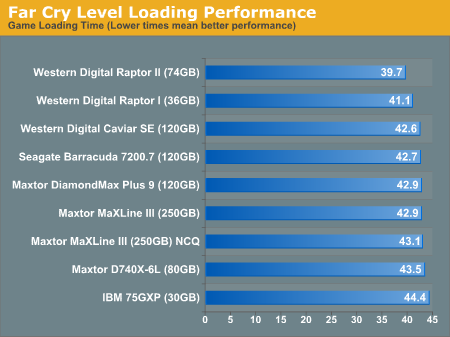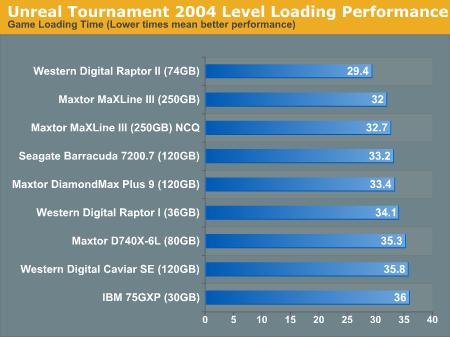Maxtor's MaXLine III 250GB: Bringing 16MB Buffers and NCQ to Hard Drives
by Anand Lal Shimpi on June 25, 2004 12:03 AM EST- Posted in
- Storage
Game Loading Performance
For our game loading tests, we used two games: Far Cry and Unreal Tournament 2004. Both games were installed, in full, to the hard drive. We then used no-CD patches to prevent any accessing of the CD/DVD drive to skew the loading process. Both games were installed to a clean drive without anything else present on the drive (the OS is located on a separate drive).Our Far Cry test consists of starting a campaign with the default difficulty level, hitting Escape to skip the introductory movie, and beginning the stop watch timer at first sight of the loading screen. The stop watch timer is stopped as soon as the loading screen disappears. The test is repeated three times with the final score reported being an average of the three. In order to avoid the effects of caching, we reboot between runs. All times are reported in seconds, lower scores obviously being better.

The larger buffer doesn't seem to help Maxtor here as the MaXLine posts competitive, but not amazing, performance scores.
Our Unreal Tournament 2004 test uses the full version of the game and leaves all settings on defaults. After launching the game, we select Instant Action from the menu, choose Assault mode and select the Robot Factory level. The stop watch timer is started right after the Play button is clicked, and stopped when the loading screen disappears. The test is repeated three times with the final score reported being an average of the three. In order to avoid the effects of caching, we reboot between runs. All times are reported in seconds, lower scores obviously being better.

In UT, the performance of the MaXLine III is a bit more impressive, but still unable to dethrone the Raptor. We've found that our UT test is much heavier on the sequential transfers and thus, the 16MB buffer manages to help out a bit here. Once again, no benefit to NCQ in applications that are already very sequential in nature.










38 Comments
View All Comments
titte - Wednesday, February 22, 2006 - link
I would strongly discourage from buing a disk from Maxtor. I recently bought a 250gig Maxline III but the disk fails to work with my nForce-chipset. The disk works ok on other machine and it's not a driver issue since Maxtors boot ISO fails to read/write to the disk. There is an article about the issue here http://www.theinquirer.net/?article=29570">http://www.theinquirer.net/?article=29570 and i also found an issue in the maxtor knowledgebase (can't seem to find it anymore though). This would be ok if maxtor support was up to the task but their resonses are almost autogenerated answers like "reinstall drivers". My problem description clearly states that drivers has been reinstalled and drive fails even when started from their diagnostics boot CD....darksage429 - Thursday, October 14, 2004 - link
Two questions:If you were to run them in RAID-0, would it beat Raptor's RAID-0 performance?
and
Would NCQ benefit those running Bittorrent?
Kaido - Tuesday, June 29, 2004 - link
Raptor + NCQ + 16mb cache = $250 *I'm* willing to pay :DSo is this going to be an Intel-only thing like Hyperthreading, or will it be available on AMD motherboards too...an a64 with this Maxtor hard drive would be sick! :)
Kaido - Tuesday, June 29, 2004 - link
TrogdorJW - Tuesday, June 29, 2004 - link
33 - I believe the article on Storage Review specifically stated that they will be doing an NCQ article in the near future, once they get all the necessary hardware in.quanta - Tuesday, June 29, 2004 - link
I read the storagereview's article, but it did not test drive's NCQ capability. Rather, it only tested 'non-native' TCQ.DerekWilson - Sunday, June 27, 2004 - link
The arguement is still that NCQ will be more helpful the more multi-tasking oriented our systems become.As for me, I sure could use it right now. I'm always playing MP3s, editing large sound and image files (photoshop is an insane resource hog), copying files between drives, and opening huge PDF, PPT and Word documents (I really wish marketing people would realize that we don't need print quality images in our online presentations). Most of the CDs I use everyday are actually images on my drive that I mount using Daemon Tools.
I would also argue that everything is HD limited. Whenever you power up, open a program, or open a large file that little hourglass alwasy rears its ugly head. Sure, once everything gets shuffled off into RAM things are fine, but that wait time is still the most annoying bottleneck in my system. And if you've ever wanted to open or copy more than one file or program at a time, then there's an argument for NCQ.
Pariah - Saturday, June 26, 2004 - link
"The raptor has TCQ, which is basically the same, but in the raptor's case, it is actually an ATA implementation. TCQ has been around for awhile, originally from SCSI."Without going into the technical differences, which nobody probably cares about, the Raptor TCQ is quite different from SATA II NCQ. While SATA II NCQ is actually closer to current SCSI TCQ than the Raptor legacy ATA TCQ is. TCQ is a rather generic term used to describe a whole bunch of different schemes. NCQ is just a name used to describe the new form of TCQ used in SATA.
"Both Intel and AMD are banking the future of their microprocessor designs heavily on a shift towards more multithreaded/multitasking usage patterns."
It would appear to be more the other way around. Intel and AMD aren't betting on that, they really don't have a choice, and everyone else will have to adapt to that whether they like it or not. Intel has seen there is a limit to how fast you can push the clockrates of current CPU tech before the heat and power requirements exceed what is practical for users. In comes Pentium M, out goes Tejas. You can't compare CPU development to hard drive development because they don't run in parallel (no pun intended). There are quite a few CPU limited applications for home users even today, while there are very few HD limited applications, and even fewer scenarios where any of us would be running multiple such applications. For TCQ/NCQ to be effective, a user truly has to be hammering their drives and that is a rare occurence and unlikely to be for any length of time.
There's a reason it has taken so long for the technology to reach ATA, and it has nothing to do with the evolution of the home user. One form of TCQ has been in PATA for years, but no one every used it because there was no use for it in the home. There still isn't, the difference now is that ATA, and more specifically SATA, is moving into the lowend enterprise and server markets which DO benefit from such technologies. The ability to use SATA drives on upcoming SAS controllers is further evidence that the markets are blurring a bit in the middle between ATA and SCSI. The needs of users haven't changed, nor are they, the target markets for the technologies have changed.
"Right now I've got an IM client, an email client, a handful of browsers, Excel, Word, a calendar app, Photoshop and iTunes running. Of those, I'm concurrently managing tasks in the browser, MP3 player and Mail applications."
Yup, those are some pretty hardcore HD usage applications. I bet you can just hear your drive grinding away under that workload.
Anand Lal Shimpi - Saturday, June 26, 2004 - link
brentpresleyTCQ won't be nearly as widely used as NCQ on the desktop, I expect the Raptor to be the only desktop SATA drive to support it; as far as I know, no chipset manufacturer is planning on including TCQ support in their south bridges.
FacelessNobody
NCQ, like Hyper Threading, improves performance in multitasking situations and not in single thread, single application scenarios. Both Intel and AMD are banking the future of their microprocessor designs heavily on a shift towards more multithreaded/multitasking usage patterns. I would tend to agree that this is a fairly logical progression for PCs to take. Already today we do some fairly heavy multitasking on PCs. Right now I've got an IM client, an email client, a handful of browsers, Excel, Word, a calendar app, Photoshop and iTunes running. Of those, I'm concurrently managing tasks in the browser, MP3 player and Mail applications. Start adding media encoding (which will happen once more people start using their PCs as media servers as well as work/play machines), multiuser environments (e.g. someone using the computer to play a game while someone else uses the same system to work in Word) through technologies like Vanderpool and then you have a clear benefit to technologies like NCQ and Hyper Threading. I'd honestly be curious to see the impact of NCQ on Media Center systems, I'd expect there to be a sizable performance boost - the only difficult part is measuring performance to be able to put into a graph.
Take care,
Anand
brentpresley - Saturday, June 26, 2004 - link
74GB raptor is TCQ, as this document shows:http://www.westerndigital.com/en/library/sata/2579...
Still, it would have been nice to compare the raptor running tcq w/ the maxtor ncq. Both are next-gen desktop technologies.